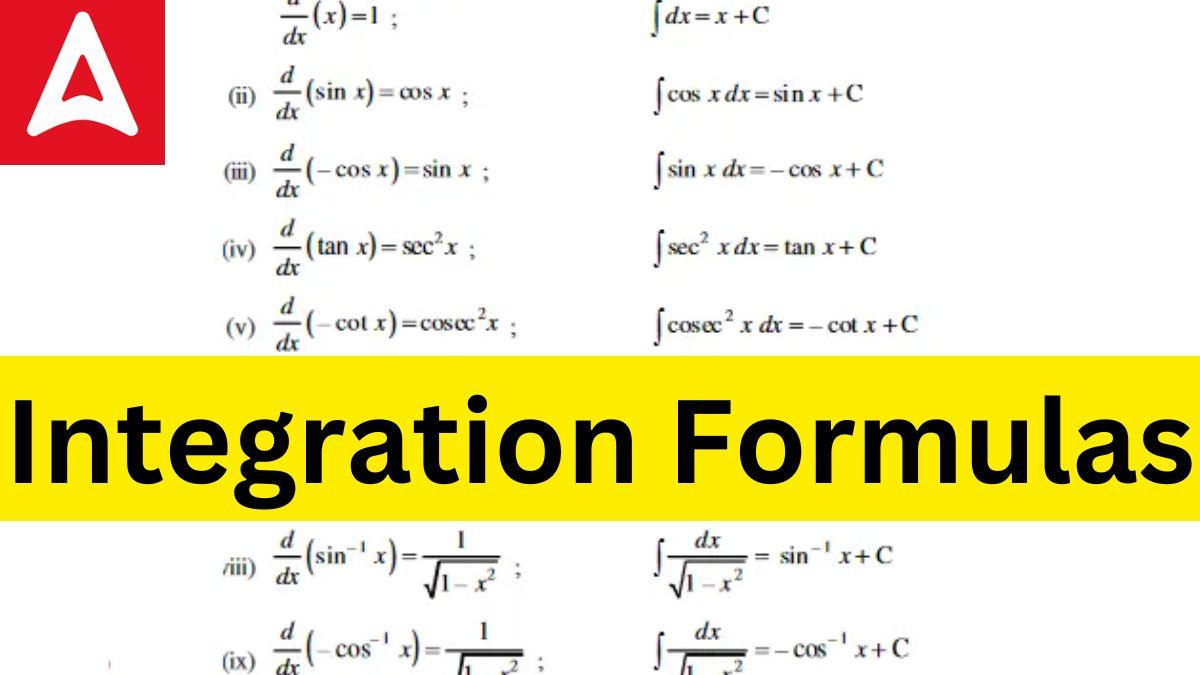Algebraic expressions, trigonometric ratios, inverse trigonometric functions, logarithmic and exponential functions can all be integrated using integration formulas. The basic functions for which the derivatives were produced are obtained by integrating functions. Integration can be seen as the inverse of differentiation or known as Inverse Differentiation.
Integration Formulas
These integration formulas are used to obtain a function and it’s derivative. We acquire a family of functions in I when we differentiate a function f in an interval I. We can determine the function f if we know the values of functions in I. Integration is the opposing process of differentiation. Let’s take it a step further and look at the integration formulas that are employed in integration procedures.
Integration involves determining a function that has a given derivative. Here are various basic integration formulas for different functions. In addition to the fundamental integration formulas, this section also provides a breakdown of integral formulas and some example questions for practicing with the integration formulas discussed in this article.
Integration Formula
The following sets of formulas are a general presentation of the integration formulas. Basic integration formula are, integration of trigonometric ratios, inverse trigonometric functions, the product of functions, and a more complex set of integration formulas are all included. Integration is essentially a method of joining the parts to create the whole. It is differentiation’s opposite action. The fundamental integration equation is thus f'(x) dx = f(x) + C.
Integration Formulas Class 12
The calculation of an integral is known as integration. Integrals are used in arithmetic to calculate a variety of useful quantities such as areas, volumes, displacement, and so on. When we talk about integrals, we usually mean definite integrals. For ant derivatives, indefinite integrals are utilized. Apart from differentiation, integration is one of the two major calculus subjects in mathematics that measures the rate of change of any function with regard to its variables. It’s a broad topic that’s covered in upper-level classes like Class 11 and 12.
All Integration Formulas PDF
Integration Formulas PDFs are given below and Check all integration formula sheets.
Integration All Formulas PDF Download
All Integration Formula Pdf is very useful for all Board Students and other competition exams candidates. Download this pdf to score well in board exams.
Click Here to Download INTEGRATION FORMULAE PDF
Integration Formulas for Class 12 and 11 Students
The most common integration formulas include:
- Constant rule: ∫c dx = cx + C, where c is a constant.
- Power rule: ∫x^n dx = (x^(n+1))/(n+1) + C, where n ≠ -1.
- Sum and difference rules: ∫(f(x) ± g(x)) dx = ∫f(x) dx ± ∫g(x) dx.
- Constant multiple rule: ∫c * f(x) dx = c * ∫f(x) dx.
- Trigonometric functions: ∫sin(x) dx = -cos(x) + C, ∫cos(x) dx = sin(x) + C, ∫sec^2(x) dx = tan(x) + C, ∫sec(x)tan(x) dx = sec(x) + C.
- Inverse trigonometric functions: ∫csc^2(x) dx = -csc(x)cot(x) + C, ∫sec(x)cot(x) dx = ln|sec(x) + tan(x)| + C.
- Logarithmic functions: ∫(1/x) dx = ln|x| + C, ∫ln(x) dx = xln(x) – x + C.
- Exponential functions: ∫e^x dx = e^x + C.
- Integration by substitution: ∫f(g(x))g'(x) dx = ∫f(u) du, where u = g(x).
- Integration by parts: ∫u dv = uv – ∫v du, where u and v are functions of x.
- Trigonometric substitution: ∫(a^2 – x^2)^(1/2) dx = a ∫sec^2(θ) dθ, where x = a sin(θ) or x = a tan(θ)
- partial fraction decomposition: ∫(f(x)/(ax+b)) dx = ln|ax+b| + C
Note: C is the constant of integration.
All Integration Formulas Sheet List wise
The basic integral formulas are given below:
- ∫ 1 dx = x + C
- ∫ a dx = ax+ C
- ∫ xn dx = ((xn+1)/(n+1))+C ; n≠1
- ∫ sin x dx = – cos x + C
- ∫ cos x dx = sin x + C
- ∫ sec2x dx = tan x + C
- ∫ cosec2x dx = -cot x + C
- ∫ sec x (tan x) dx = sec x + C
- ∫ cosec x ( cot x) dx = – cosec x + C
- ∫ (1/x) dx = ln |x| + C
- ∫ ex dx = ex+ C
- ∫ ax dx = (ax/ln a) + C ; a>0, a≠1
- ∫ tanx.dx =log|secx| + C
- ∫ cotx.dx = log|sinx| + C
- ∫ secx.dx = log|secx + tanx| + C
- ∫ cosecx.dx = log|cosecx – cotx| + C
Integration Formulas of Inverse Trigonometric Functions with limits
- ∫ 1/(1 +x2 ).dx = -cot-1x + C
- ∫ 1/x√(x2 – 1).dx = sec-1x + C
- ∫ 1/x√(x2 – 1).dx = -cosec-1 x + C
- ∫1/√(1 – x2).dx = sin-1x + C
- ∫ /1(1 – x2).dx = -cos-1x + C
- ∫1/(1 + x2).dx = tan-1x + C
List of Difficult Integration Formulas
- ∫ √(x2 + a2 ).dx =1/2.x.√(x2 + a2 )+ a2/2 . log|x + √(x2 + a2 )| + C
- ∫1/(x2 + a2).dx = 1/a.tan-1x/a + C
- ∫1/√(x2 – a2)dx = log|x +√(x2 – a2)| + C
- ∫ √(x2 – a2).dx =1/2.x.√(x2 – a2)-a2/2 log|x + √(x2 – a2)| + C
- ∫1/√(a2 – x2).dx = sin-1 x/a + C
- ∫1/(x2 – a2).dx = 1/2a.log|(x – a)(x + a| + C
- ∫ 1/(a2 – x2).dx =1/2a.log|(a + x)(a – x)| + C
- ∫1/√(x2 + a2 ).dx = log|x + √(x2 + a2)| + C
- ∫√(a2 – x2).dx = 1/2.x.√(a2 – x2).dx + a2/2.sin-1 x/a + C
Integration Formula Top 10 useful formulas
Here is a list of commonly used integration formulas:
- Power Rule: ∫x^n dx = (1/(n+1)) * x^(n+1), where n ≠ -1
- Constant Rule: ∫k dx = kx + C, where k is a constant
- Exponential Function: ∫e^x dx = e^x + C
- Natural Logarithm: ∫(1/x) dx = ln|x| + C
- Trigonometric Functions:
- ∫sin(x) dx = -cos(x) + C
- ∫cos(x) dx = sin(x) + C
- ∫sec^2(x) dx = tan(x) + C
- ∫csc^2(x) dx = -cot(x) + C
- ∫sec(x) * tan(x) dx = sec(x) + C
- ∫csc(x) * cot(x) dx = -csc(x) + C
- Inverse Trigonometric Functions:
- ∫(1/√(1-x^2)) dx = arcsin(x) + C
- ∫(1/(1+x^2)) dx = arctan(x) + C
- Logarithmic Functions:
- ∫(1/(xln(a))) dx = ln|ln(a)| + C, where a > 0 and a ≠ 1
- ∫(1/x) ln(x) dx = (1/2)ln^2(x) + C
- Hyperbolic Functions:
- ∫sinh(x) dx = cosh(x) + C
- ∫cosh(x) dx = sinh(x) + C
- ∫sech^2(x) dx = tanh(x) + C
- Rational Functions:
- ∫(1/(x^2 + a^2)) dx = (1/a)arctan(x/a) + C, where a ≠ 0
- ∫(1/(x^2 – a^2)) dx = (1/(2a))ln|(x-a)/(x+a)| + C, where a ≠ 0
- Integration by Parts: ∫u dv = uv – ∫v du, where u and v are differentiable functions
Integration Formulas for Engineering
Integration is one of the most important concepts that find a wide range of applications in engineering domain. So, any student who desire to become an Engineer must develop a solid foundation in this topic. Some of the integration formulas necessary for engineering aspirants are given below.
- ∫sin(x) dx = -cos(x) + C
- ∫cos(x) dx = sin(x) + C
- ∫sec²(x) dx = tan(x) + C
- ∫csc²(x) dx = -cot(x) + C
- ∫sec(x) * tan(x) dx = sec(x) + C
- ∫csc(x) * cot(x) dx = -csc(x) + C
- ∫1/√(1 – x2).dx = sin-1x + C
- ∫ -1/x√(x2 – 1).dx = cosec-1x + C
- ∫-1/√(1 – x2).dx = cos-1x + C
- ∫ 1/x√(x2 – 1).dx = sec-1x + C
- ∫1/(1 + x2).dx = tan-1x + C
- ∫-1/(1 + x2).dx = cot-1x + C
Integration Formula UV
The integration formula UV is a special type of integration rule known as integration by parts. The Integration formula for UV is also commonly known by the name product rule of integration. Here, we combine the results of two functions. If we are given with two functions: u(x) and v(x), and they are of the type ∫u dv, then the Integration of uv formula is expressed as:
- ∫ uv dx = u ∫ v dx – ∫ (u’ ∫ v dx) dx , u is the first function and v is the second function
- ∫ u dv = uv – ∫ v du , here u is the first function and dv is the second function
To find out the first function, i.e., u, we use the ILATE or LIATE rule, where
I – Inverse trigonometric function
A – Algebraic function
T – Trigonometric function
E – Exponential function
The functions are assigned the higher priority of u from up to down. It can be though of as an analogous rule of BODMAS. For example, if we have been given a logarithmic function and a trigonometric function, then u will be logarithmic function and v will be trigonometric function.
Integration Formulas- Application
There are two sorts of integrals in general. They are integrals that are either definite or indefinite..
Definite Integration Formula
These are integrations with a pre-existing value of limits, resulting in a determined end value of integral.
b∫ag(x)dx
= G(b) – G(a)
Indefinite Integration Formula
These are integrations that do not have a pre-existing limit value, rendering the integral’s final value indefinite. The integration constant C is used here. g'(x) = g(x) + C
We use the integration formulas discussed so far in approximating the area bounded by curves, evaluating average distance, velocity, and acceleration oriented problems, finding the average value of a function, approximating the volume and surface area of solids, estimating the arc length, and finding the kinetic energy of a moving object using improper integrals.
Integration
Integration is a fundamental concept in calculus that involves finding the integral of a function. The integral of a function represents the area under the curve of the function over a certain interval. It also has applications in calculating quantities such as displacement, area, volume, and more.
There are two main types of integrals: definite integrals and indefinite integrals.
- Indefinite Integral: The indefinite integral of a function is denoted as , and it represents the family of functions whose derivative is . The result includes an arbitrary constant :where is an antiderivative of .
- Definite Integral: The definite integral of a function over an interval is denoted as . It represents the signed area between the curve of and the x-axis over the interval :where f(x) is an antiderivative of .
Integration involves various techniques, including substitution, integration by parts, trigonometric integrals, and partial fractions. Some common integrals include:
- (for )
- (for )
Keep in mind that integration is a vast topic with many nuances and applications, including definite and indefinite integrals of both elementary and more complex functions. It’s important to understand the fundamental concepts and practice various techniques to become proficient in integration.
Integration Formulas Examples
Example 1: Find the value of ∫ (9x+ 25)/ (x+3)2 .dx
Solution:
(9x+ 25)/ (x+3)2 is a rational function.
Using the partial fraction decomposition, we have (9x+ 25)/(x+3)2 = A/(x+3) + B/(x+3)2
Taking LCD, we get
(9x+ 25)/(x+3)2 = [A(x+3) +B]/(x+3)2
Equating the numerator, we get
9x+ 25 = A(x+3) +B
Solving for B when x = -3, we get B = -2
Solving for A when x = 0, we get A = 9
Thus the partial fraction is decomposed as 9/(x+3) -2/(x+3)2
As stated in the integration formulas above, find the integral of 9/(x+3) -2/(x+3)2 .
∫[9/(x+3)]dx – ∫ -2(x+3)2 .dx = 9 ln(x+3) – 2 /(x+3) +C
Example 2:∫x3+3x+4x√dx
Solution:
Example 3:∫x3−x2+x−1x−1dx
Solution:
Related Post:











 Greater Than and Less Than, Equal to Sig...
Greater Than and Less Than, Equal to Sig...
 XXV Number- XXV Roman Numerals Definitio...
XXV Number- XXV Roman Numerals Definitio...
 Ordinal Numbers: Meaning, Examples, Appl...
Ordinal Numbers: Meaning, Examples, Appl...









